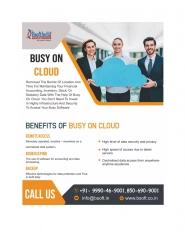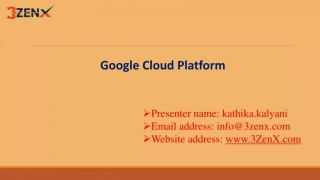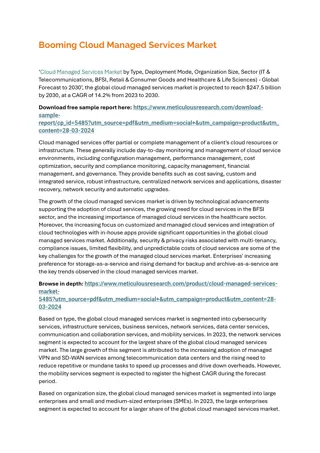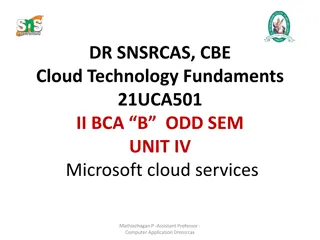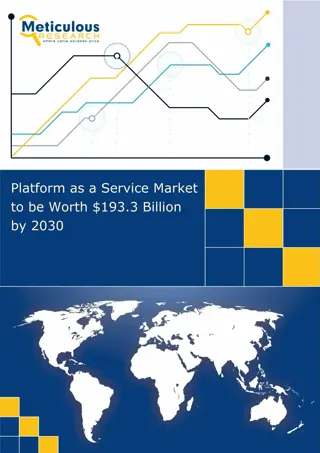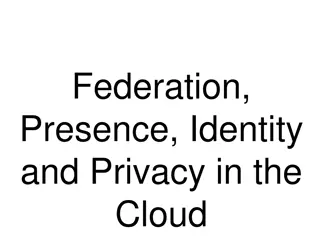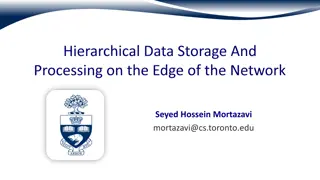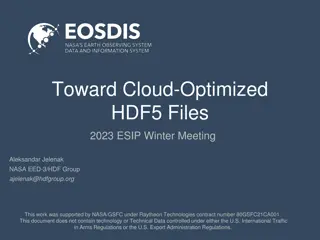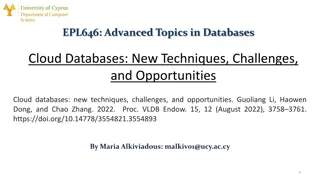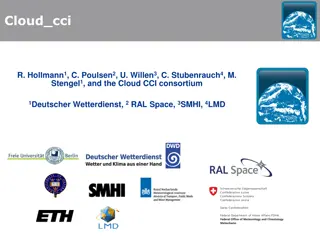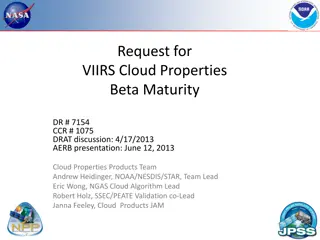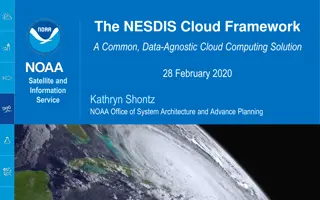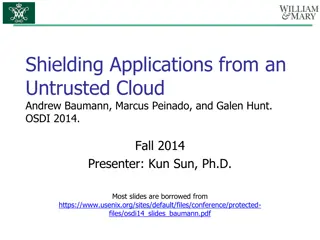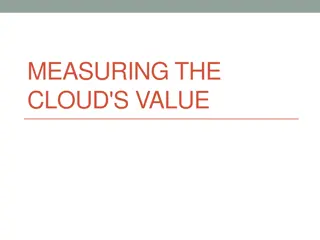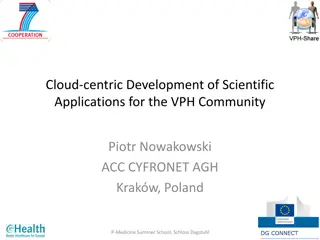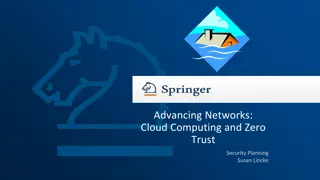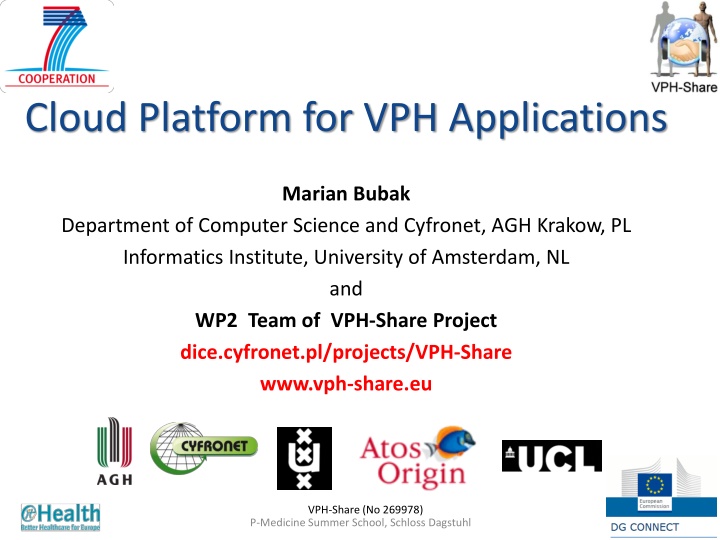
Cloud Platform for VPH Applications by Marian Bubak
This project focuses on managing cloud/HPC resources to support VPH-Share applications, catering to developers, domain scientists, and administrators. It facilitates application deployment, workflow execution, data management, and platform configuration. The platform aims to provide easy access to tools and services, secure data management, and efficient resource utilization in a hybrid cloud environment.
Download Presentation

Please find below an Image/Link to download the presentation.
The content on the website is provided AS IS for your information and personal use only. It may not be sold, licensed, or shared on other websites without obtaining consent from the author. If you encounter any issues during the download, it is possible that the publisher has removed the file from their server.
You are allowed to download the files provided on this website for personal or commercial use, subject to the condition that they are used lawfully. All files are the property of their respective owners.
The content on the website is provided AS IS for your information and personal use only. It may not be sold, licensed, or shared on other websites without obtaining consent from the author.
E N D
Presentation Transcript
Cloud Platform for VPH Applications Marian Bubak Department of Computer Science and Cyfronet, AGH Krakow, PL Informatics Institute, University of Amsterdam, NL and WP2 Team of VPH-Share Project dice.cyfronet.pl/projects/VPH-Share www.vph-share.eu VPH-Share (No 269978) 24 Jun 2013 P-Medicine Summer School, Schloss Dagstuhl 1
Coauthors Piotr Nowakowski, Maciej Malawski, Marek Kasztelnik, Daniel Harezlak, Jan Meizner, Tomasz Bartynski, Tomasz Gubala, Bartosz Wilk, Wlodzimierz Funika Spiros Koulouzis, Dmitry Vasunin, Reggie Cushing, Adam Belloum Stefan Zasada Dario Ruiz Lopez, Rodrigo Diaz Rodriguez 24 Jun 2013 P-Medicine Summer School, Schloss Dagstuhl 2
Outline Motivation Architecture Overview of platform modules Use cases Current functionality Scientific objectives Technologies applied Summary and further development 24 Jun 2013 P-Medicine Summer School, Schloss Dagstuhl 3
Cloud computing What the Cloud computing is? Unlimited access into computing power and data storage Virtualization technology (enables to run many isolated operating systems on one physical machine) Lifecycle management (deploy/start/stop/restart) Scalability Pay per use charging model What the Cloud computing isn t? Magic platform to scale your application from your PC automaticaly Secure place where sensitive data can be stored (that is why we need security and data anonimization ) 24 Jun 2013 P-Medicine Summer School, Schloss Dagstuhl 4
Motivation: 3 groups of users The goal of of the platform is to manage cloud/HPC resources in support of VPH-Share applications by: Providing a mechanism for application developers to install their applications/tools/services on the available resources Providing a mechanism for end users (domain scientists) to execute workflows and/or standalone applications on the available resources with minimum fuss Providing a mechanism for end users (domain scientists) to securely manage their binary data in a hybrid cloud environment Providing administrative tools facilitating configuration and monitoring of the platform End user support Easy access to applications and binary data Generic service Application Cloud Platform Interface Manage hardware resources Heuristicallydeploy services Ensure accessto applications Keep track of binary data Enforce commonsecurity Application Developer support Tools for deploying applications and registering datasets Application Data Data Data Admin support Management of VPH- Share hardware resources Hybrid cloud environment (public and private resources) 24 Jun 2013 P-Medicine Summer School, Schloss Dagstuhl 5
A very short glossary Raw OS ! Virtual Machine: A self-contained operating system image, registered in the Cloud framework and capable of being managed by VPH-Share mechanisms. OS Atomic service: A VPH-Share application (or a component thereof) installed on a Virtual Machine and registered with the cloud management tools for deployment. ! VPH-Share app. (or component) External APIs Cloud host OS Atomic service instance: A running instance of an atomic service, hosted in the Cloud and capable of being directly interfaced, e.g. by the workflow management tools or VPH-Share GUIs. ! VPH-Share app. (or component) External APIs 24 Jun 2013 P-Medicine Summer School, Schloss Dagstuhl 6
Cloud platform offer Scale your applications in the Cloud ( unlimited computer power/reliable storage) Use resources in the cost-effective way Install/configure (Atomic Service) once use multiple times in different workflows Many instances of Atomic Services can be instantiated automatically Heavy computation can be delegated from the PC into the cloud/HPC Smart deployment: computation will be executed close to the data or the other way round Multitudes of operating systems to choose from Install whatever you want (root access to the machine) 24 Jun 2013 P-Medicine Summer School, Schloss Dagstuhl 7
Architecture of cloud platform Admin Modules available in advanced prototype Work Package 2: Data and Compute Cloud Platform Atomic Service Instances Developer Scientist Deployed by AMS (T2.1) on available resources as required by WF mgmt (T6.5) or generic AS invoker (T6.3) VPH-Share Master UI AM VPH-Share Tool / App. Service AS mgmt. interface T2.1 Generic AS invoker Raw OS (Linux variant) VM AS images Workflow description and execution templates LOB Federated storage access 101101 011010 111011 111011 111011 101101 011010 011010 101101 Security mgmt. interface Web Service cmd. wrapper DRI Computation UI extensions Available cloud infrastructure Managed datasets Web Service security agent Service T6.3, 6.5 Generic VNC server T2.5 Atmosphere persistence layer (internal registry) Data mgmt. interface Generic data retrieval Data mgmt. UI extensions Security framework LOB federated storage access T6.4 T2.4 T2.6 Custom AS client Physical resources Remote access to Atomic Svc. UIs Cloud stack clients HPC resource client/backend T6.1 T2.2 T2.3 24 Jun 2013 P-Medicine Summer School, Schloss Dagstuhl 8
Resource allocation management Management of the VPH-Share cloud features is done via the Cloud Facade which provides a set of APIs for the Master Interface and any external application with the proper security credentials. Developer Admin Scientist VPH-Share Core Services Host Atmosphere Management Service (AMS) Cloud Facade (secure RESTful API ) VPH-Share Master Int. Cloud Manager Atmosphere Internal Registry (AIR) Cloud stack plugins (JClouds) Development Mode Generic Invoker Workflow management OpenStack/Nova Computational Cloud Site Other CS External application Head Node Worker Node Worker Node Worker Node Worker Node Cloud Facade client Amazon EC2 Customized applications may directly interface the Cloud Facade via its RESTful APIs Worker Node Worker Node Worker Node Worker Node Image store (Glance) 24 Jun 2013 P-Medicine Summer School, Schloss Dagstuhl 9
Cloud execution environment Private cloud sites deployed at CYFRONET, USFD and UNIVIE A survey of public IaaS cloud providers has been performed Performance and cost evaluation of EC2, RackSpace and SoftLayer A grant from Amazon has been obtained and @neuFuse services are deployed on Amazon resources Per- hour instance billing 5 1 1 1 1 1 1 1 1 0 0 0 0 0 1 0 0 1 1 1 0 1 1 0 1 1 0 0 1 1 0 1 1 1 1 1 0 1 1 1 0 0 1 1 0 1 0 1 0 1 VM Image Import / Export 3 0 0 0 1 1 1 0 1 0 1 0 0 0 1 1 1 0 0 0 1 0 0 0 1 0 1 1 1 0 0 1 0 0 0 0 0 1 1 0 0 0 0 1 0 1 0 1 0 0 jClouds API Support 20 1 1 1 1 1 1 1 1 1 1 1 1 0 0 0 0 0 0 0 0 0 0 0 0 0 0 0 1 0 0 0 0 0 0 0 0 1 0 0 0 0 0 1 0 1 0 0 0 0 BLOB storage support 10 1 1 1 0 0 0 0 0 0 0 0 0 0 0 0 0 0 0 0 0 0 0 0 0 1 0 0 1 1 0 0 1 0 1 1 0 0 1 0 0 0 1 0 0 0 0 0 0 1 Relational DB support 2 1 1 0 0 0 0 0 0 1 0 0 0 1 0 0 0 0 0 0 0 0 0 0 0 1 0 1 1 1 0 0 0 0 0 1 0 0 0 0 0 0 0 0 0 0 0 0 0 1 EEA Zoning 20 1 1 1 1 1 1 1 1 1 1 1 1 0 1 1 1 1 0 0 1 1 1 0 1 1 0 0 0 0 0 1 0 0 1 1 1 0 1 1 1 0 0 0 0 0 0 1 1 1 API Access 5 1 1 1 1 1 1 1 1 1 1 1 1 0 1 1 0 1 0 1 0 1 0 0 1 1 1 0 1 1 0 0 1 1 1 1 0 1 1 1 0 0 0 1 0 1 1 1 1 1 Published price 5 1 1 1 1 1 1 1 0 1 0 0 0 1 1 0 0 1 0 1 0 0 1 1 1 1 0 1 1 1 0 1 1 1 1 1 1 1 1 1 1 0 1 1 0 1 0 1 1 1 IaaS Provider Weight Amazon AWS Rackspace SoftLayer CloudSigma ElasticHosts Serverlove GoGrid Terremark ecloud RimuHosting Stratogen Bluelock Fujitsu GCP BitRefinery BrightBox BT Global Services Carpathia Hosting City Cloud Claris Networks Codero CSC Datapipe e24cloud eApps FlexiScale Google GCE Green House Data Hosting.com HP Cloud IBM SmartCloud IIJ GIO iland cloud Internap Joyent LunaCloud Oktawave Openhosting.co.uk Openhosting.com OpSource ProfitBricks Qube ReliaCloud SaavisDirect SkaliCloud Teklinks Terremark vcloud Tier 3 Umbee Score 27 27 25 18 18 18 15 13 12 8 5 5 0 0 0 0 0 0 0 0 0 0 0 0 0 0 0 0 0 0 0 0 0 0 0 0 0 0 0 0 0 0 0 0 0 0 0 0 0 1 2 3 4 5 6 7 8 9 10 11 12 13 14 15 16 17 18 19 20 21 22 23 24 25 26 27 28 29 30 31 32 33 34 35 36 37 38 39 40 41 42 43 44 45 46 47 24 Jun 2013 P-Medicine Summer School, Schloss Dagstuhl 48 VPS.net 49 Windows Azure 10
HPC execution environment Provides virtualized access to high performance execution environments Seamlessly provides access to high performance computing to workflows that require more computational power than clouds can provide Deploys and extends the Application Hosting Environment provides a set of web services to start and control applications on HPC resources Application Hosting Environment Invoke the Web Service API of AHE to delegate computation to the grid Auxiliary component of the cloud platform, responsible for managing access to traditional (grid-based) high performance computing environments. Provides a Web Service interface for clients. Present security token (obtained from authentication service) Application AHE Web Services (RESTlets) -- or -- User access layer WebDAV GridFTP Tomcatcontainer Workflow environment Resource client layer Job Submission Service (OGSA BES / Globus GRAM) QCG RealityGrid SWS Computing -- or -- Delegate credentials, instantiate computing tasks, poll for execution status and retrieve results on behalf of the client End user Grid resources running Local Resource Manager (PBS, SGE, Loadleveler etc.) 24 Jun 2013 P-Medicine Summer School, Schloss Dagstuhl 11
Data access for large binary objects Ticket validation service Master Interface component LOBCDER host (149.156.10.143) Auth service WebDAV servlet Core component host (vph.cyfronet.pl) Data Manager Portlet (VPH-Share Master Interface component) REST-interface LOBCDER service backend GUI-based access Resource factory Storage driver (SWIFT) Storage driver Atomic Service Instance (10.100.x.x) Service payload (VPH-Share application component) Encryption keys Resource catalogue Mounted on local FS (e.g. via davfs2) SWIFT storage backend External host Generic WebDAV client VPH-Share federated data storage module (LOBCDER) enables data sharing in the context of VPH-Share applications The module is capable of interfacing various types of storage resources and supports SWIFT cloud storage (support for Amazon S3 is under development) LOBCDER exposes a WebDAV interface and can be accessed by any DAV-compliant client. It can also be mounted as a component of the local client filesystem using any DAV-to-FS driver (such as davfs2). 24 Jun 2013 P-Medicine Summer School, Schloss Dagstuhl 12
Approach to data federation Need for loosely-coupled flexible distributed easy to use architecture Build on top of existing solutions To aggregate a pool of resources in a client-centric A standardized protocol that can be also mounted Provide a file system abstraction A common management layer that loosely couples independent storage resources As a result, distributed applications have a global shared view of the whole available storage space Applications can be developed locally and deployed on the cloud platform without changing the data access parameters Use storage space efficiently with the copy-on-write strategy Replication of data can be based on efficiency cost measures Reduce the risk of vendor lock-in in clouds since no large amount of data are on a single provider 24 Jun 2013 P-Medicine Summer School, Schloss Dagstuhl 13
LOBCDER transparency LOBCDER locates files and transport data providing: Access transparency: clients are unaware that files are distributed and may access them in the same way as local files are accessed Location transparency: a consistent namespace encompasses remote files The name of a file does not give its location Concurrency transparency: all clients have the same view of the state of the file system Heterogeneity: provided across different hardware operating system platforms Replication transparency: replicate files across multiple servers and clients are unaware of it Migration transparency: files are move around without the client's knowledge LOBCDER loosely couples a variety of storage technologies such as Openstack- Swift , iRODS , GridFTP 24 Jun 2013 P-Medicine Summer School, Schloss Dagstuhl 14
Usage statistics for LOBCDER 24 Jun 2013 P-Medicine Summer School, Schloss Dagstuhl 15
Data storage security Problem: How to ensure secure storage of confidential data in public clouds where it could be efficiently processed by application services and controlled by administrators (including guaranteed erasure on demand)? Current status: The SWIFT data storage resources on which LOBCDER is based are managed internally by Consortium members and belong to their private cloud infrastructures. Under these conditions access to sensitive data is tightly controlled and security risks remain minimal. A thorough analysis of data instancing on cloud resources and possibilities for malicious access and clean-up processes after instance closing has been conducted. Proposed solutions (detailed in State of the Art document published by CYF in April 2013): Data sharding: procurement of multiple storage resources and ensuring that each resource only receives a nonrepresentative subset of each dataset On-the-fly encryption, either built into the platform or enforced on the application/AS level Volatile-memory storage infrastructure (i.e. storage of confidential data in service RAM only, with sufficient replication to guard against potential failures) 24 Jun 2013 P-Medicine Summer School, Schloss Dagstuhl 16
Data reliability and integrity Provides a mechanism which keeps track of binary data stored in cloud infrastructure Monitors data availability Advises the cloud platform when instantiating atomic services LOBCDER DRI Service Metadata extensions for DRI A standalone application service, capable of autonomous operation. It periodically verifies access to any datasets submitted for validation and is capable of issuing alerts to dataset owners and system administrators in case of irregularities. Validation policy Binary data registry Register files Get metadata Migrate LOBs Get usage stats (etc.) Configurable validation runtime (registry-driven) Runtime layer Extensible resource client layer End-user features (browsing, querying, direct access to data, checksumming) Amazon S3 OpenStack Swift Cumulus VPH Master Int. Store and marshal data Data management portlet (with DRI management extensions) Distributed Cloud storage 24 Jun 2013 P-Medicine Summer School, Schloss Dagstuhl 17
Security framework Provides a policy-driven access system for the security framework. Provides a solution for an open-source based access control system based on fine-grained authorization policies. Implements Policy Enforcement, Policy Decision and Policy Management Ensures privacy and confidentiality of eHealthcare data Capable of expressing eHealth requirements and constraints in security policies (compliance) Tailored to the requirements of public clouds VPH clients (or any authorized user capable of presenting a valid security token) Application Workflow managemen t service Developer End user Administrator VPH Security Framework Public internet VPH Security Framework VPH Atomic Service Instances 24 Jun 2013 P-Medicine Summer School, Schloss Dagstuhl 18
Security and atomic services The application API is only exposed to localhost clients Calls to Atomic Services are intercepted by the Security Proxy Each call carries a user token (passed in the request header) The user token is digitally signed to prevent forgery. This signature is validated by the Security Proxy The Security Proxy decides whether to allow or disallow the request on the basis of its internal security policy Cleared requests are forwarded to the local service instance VPH-Share Atomic Service Instance Actual application API (localhost access only) Security Proxy 2. Intercept request Service payload (VPH-Share application component) 1. Incoming request 5. Relay original request (if cleared) Public AS API (SOAP/REST) Security Policy 3 , 4 Report error 6. Intercept service response Exposed externally by local web server (apache2/tomcat) 7. Relay response 3. Decrypt and validate the digital signature with the VPH-Share public key. 5. Otherwise, relay the original request to the service payload. Include the user token for potential use by the service itself. User token a6b72bfb5f2466512a b2700cd27ed5f84f99 1422rdiaz!developer! rdiaz,Rodrigo Diaz,rodrigo.diaz@at osresearch.eu,,SPAIN, 08018 4. If the digital signature checks out, consult the security policy to determine whether the user should be granted access on the basis of his/her assigned roles. 6-7. The service response is relayed to the original client. This mechanism is entirely transparent from the point of view of the person/application invoking the Atomic Service. 3 , 4 . If the digital signature is invalid or if the security policy prevents access given the user s existing roles, the Security Proxy throws a HTTP/401 (Unauthorized) exception to the client. digital signature unique username assigned role(s) additional info 24 Jun 2013 P-Medicine Summer School, Schloss Dagstuhl 19
Sensitivity analysis application Problem: Cardiovascular sensitivity study: 164 input parameters (e.g. vessel diameter and length) First analysis: 1,494,000 Monte Carlo runs (expected execution time on a PC: 14,525 hours) Second Analysis: 5,000 runs per model parameter for each patient dataset; requires another 830,000 Monte Carlo runs per patient dataset for a total of four additional patient datasets this results in 32,280 hours of calculation time on one personal computer. Total: 50,000 hours of calculation time on a single PC. Solution: Scale the application with cloud resources. Scientist Launcher script VPH-Share implementation: Scalable workflow deployed entirely using VPH- Share tools and services. Consists of a RabbitMQ server and a number of clients processing computational tasks in parallel, each registered as an Atomic Service. The server and client Atomic Services are launched by a script which communicates directly withe the Cloud Facade API. Small-scale runs successfully competed, large- scale run in progress. Secure API Server AS Atmosphere RabbitMQ Cloud Facade Atmosphere Management Service (Launches server and automatically scales workers) DataFluo DataFluo Listener Worker AS Worker AS RabbitMQ RabbitMQ 24 Jun 2013 P-Medicine Summer School, Schloss Dagstuhl 20
p-medicine OncoSimulator P-Medicine users VPH-Share Computational Cloud Platform Atmosphere Management Service (AMS) Cloud Facade AIR registry P-Medicine Portal OncoSimulator Submission Form Launch Atomic Services OncoSimulator ASI Cloud WN Cloud HN OncoSimulator ASI Visualization window Mount LOBCDER and select results for storage in P-Medicine Data Cloud VITRALL Visualization Service Store output P-Medicine Data Cloud LOBCDER Storage Federation Storage resources Storage resources Deployment of the OncoSimulator Tool on VPH-Share resources: Uses a custom Atomic Service as the computational backend. Features integration of data storage resources OncoSimulator AS also registered in VPH-Share metadata store 24 Jun 2013 P-Medicine Summer School, Schloss Dagstuhl 21
Collaboration with p-medicine Application deployment The P-Medicine OncoSimulator application has been deployed as a VPH-Share Atomic Service and can be instantiated on our existing cloud resources. OncoSimulator applications have been integrated with the VPH-Share semantic registry and can be searched for using this registry. Security and sensitive data First approach to a gateway service for translating requests from one service to another: security token translation service to enable Share - P-Medicine interoperability. BioMedTown accounts provided for p-medicine users to allow them to access shared services (as sharing data in the p-medicine data warehouse requires signing and adhering to contracts governing data protection and data security). File storage A LOBCDER extension for the p-medicine data storage infrastructure is in the planning phase Due to the fact that authentication in VPH-Share is based on the security token and there are no such tokens in use within p-medicine we have extended the LOBCDER authentication model to validate user credentials not only at a remote site, but also against a local credentials DB. This allows non-VPH users to obtain authorized access to the data stored in LOBCDER. 24 Jun 2013 P-Medicine Summer School, Schloss Dagstuhl 22
Scientific objectives (1/2) Investigating the applicability of cloud computing model for complex scientific applications Optimization of resource allocation for scientific applications on hybrid cloud platforms Resource management for services on a heterogeneous hybrid cloud platform to meet demands of scientific applications Performance evaluation of hybrid cloud solutions for VPH applications Researching means of supporting urgent computing scenarios in cloud platforms, where users need to be able to access certain services immediately upon request Creating a billing and accounting model for hybrid cloud services by merging the requirements of public and private clouds Research into the use of evolutionary algorithms for automatic discovery of patterns in cloud resources provisioning Investigation of behavior-inspired optimization methods for data storage services Research in domain of operational standards towards provisioning of highly sustainable federated hybrid cloud e-Infrastructures for support of various scientific communities 24 Jun 2013 P-Medicine Summer School, Schloss Dagstuhl 23
Scientific objectives (2/2) Research on procedural and technical aspects of ensuring efficient yet secure data storage, transfer and processing featuring use of private and public storage cloud environments, taking into account full lifecycle from data generation to permanent data removal Research on Software Product Lines and Feature Modeling principles in application to Atomic Service component dependency management, composition and deployment Research on tools for Atomic Services provisioning in cloud infrastructure Design of domain-specific, consistent information representation model for VPHShare platform, its components and its operating procedures Design and development of a persistence solution to keep vital information safe and efficiently delivered to various elements of VPHShare platform Design and implementation of entity identification and naming scheme to serve as common platform of understanding between various, heterogeneous elements of VPHShare platform Defining and delivering unified API for managing scientific applications using virtual machines deployed into heterogeneous cloud Hiding cloud complexity from the user through simplified API 24 Jun 2013 P-Medicine Summer School, Schloss Dagstuhl 24
Selected publications P. Nowakowski, T. Bartynski, T. Gubala, D. Harezlak, M. Kasztelnik, M. Malawski, J. Meizner, M. Bubak: Cloud Platform for Medical Applications, eScience 2012 S. Koulouzis, R. Cushing, A. Belloum and M. Bubak: Cloud Federation for Sharing Scientific Data, eScience 2012 P. Nowakowski, T. Barty ski, T. Guba a, D. Har lak, M. Kasztelnik, J. Meizner, M. Bubak: Managing Cloud Resources for Medical Applications, Cracow Grid Workshop 2012, Krak w, Poland, 22 October 2012 M. Bubak, M. Kasztelnik, M. Malawski, J. Meizner, P. Nowakowski, and S. Varma: Evaluation of Cloud Providers for VPH Applications, CCGrid 2013 (2013) M. Malawski, K. Figiela, J. Nabrzyski: Cost Minimization for Computational Applications on Hybrid Cloud Infrastructures, FGCS 2013 D. Chang, S. Zasada, A. Haidar, P. Coveney: AHE and ACD: A Gateway into the Grid Infrastructure for VPH-Share, VPH 2012 Conference, London S. Zasada, D. Chang, A. Haidar, P. Coveney: Flexible Composition and Execution of Large Scale Applications on Distributed e-Infrastructures, Journal of Computational Science (in print). M.Sc. Thesis: Bartosz Wilk: Installation of Complex e-Science Applications on Heterogeneous Cloud Infrastructures, AGH University of Science and Technology, Krak w, Poland (August 2012), PTI award 24 Jun 2013 P-Medicine Summer School, Schloss Dagstuhl 25
Software engineering methods Scrum methodology used to organize team work Redmine (http://www.redmine.org ) as flexible project management Redmine backlog (http://www.redminebacklogs.net ) - redmine plugin for agile teams Continous delivery based on Jenkins (http://jenkins-ci.org ) Code stored in private GitLab (http://gitlab.org ) repository Short release period time: Fixed 1 month period for delivering new feature rich Atmosphere version Bug fix version released as fast as possible Versioning based on semantic versioning (http://semver.org ) Tests, tests, test TestNG Junit 24 Jun 2013 P-Medicine Summer School, Schloss Dagstuhl 26
Technologies in platform modules Component/Module Technologies used Cloud Resource Allocation Management Java application with Web Service (REST) interfaces, OSGi bundle hosted in a Karaf container, Camel integration framework Cloud Execution Environment Java application with Web Service (REST) interfaces, OSGi bundle hosted in a Karaf container, Nagios monitoring framework, OpenStack and Amazon EC2 cloud platforms High Performance Execution Environment Application Hosting Environment with Web Service (REST/SOAP) interfaces Data Access for Large Binary Objects Standalone application preinstalled on VPH-Share Virtual Machines; connectors for OpenStack ObjectStore and Amazon S3; GridFTP for file transfer Data Reliability and Integrity Standalone application wrapped as a VPH-Share Atomic Service, with Web Service (REST) interfaces; uses T2.4 tools for access to binary data and metadata storage Security Framework Uniform security mechanism for SOAP/REST services; Master Interface SSO enabling shell access to virtual machines, 24 Jun 2013 P-Medicine Summer School, Schloss Dagstuhl 27
Schedule of platform development Y0.5 Y1 Y1.5 Y2 Y2.5 Y3 Y3.5 Y4 Design phase First impl. phase Second implementation phase Third implementation phase D2.4/2.5 Adv. prototype + resource spec. Integration/deployment of app workflows D2.6 D2.1/2.2 SOTA + Design D2.3 D2.7 First deployment + service bundle candidaterelease First prototype Final evaluation and release Further iterative improvements of platform functionality o detailed plan for each module o based on emerging users' requirements o focusing on robustness and optimization of existing components (service instantiation and storage, I/O, smarter deployment policies, multi-site operation, integration of additional cloud resources and stacks) support for application development and performance testing ongoing integration with VPH-Share components; Cloud Platform API extensions enabling development of advanced external clients further collaboration with p-medicine 24 Jun 2013 P-Medicine Summer School, Schloss Dagstuhl 28
Summary: basic features of platform Install any scientific application in the cloud Access available applications and data in a secure manner End user Application Managed application Developer Cloud infrastructure for e-science Manage cloud computing and storage resources Administrator Install/configure each application service (which we call an Atomic Service) once then use them multiple times in different workflows; Direct access to raw virtual machines is provided for developers, with multitudes of operating systems to choose from (IaaS solution); Install whatever you want (root access to Cloud Virtual Machines); The cloud platform takes over management and instantiation of Atomic Services; Many instances of Atomic Services can be spawned simultaneously; Large-scale computations can be delegated from the PC to the cloud/HPC via a dedicated interface; Smart deployment: computations can be executed close to data (or the other way round). 24 Jun 2013 P-Medicine Summer School, Schloss Dagstuhl 29
More information at dice.cyfronet.pl/projects/VPH-Share www.vph-share.eu jump.vph-share.eu 24 Jun 2013 P-Medicine Summer School, Schloss Dagstuhl 30

